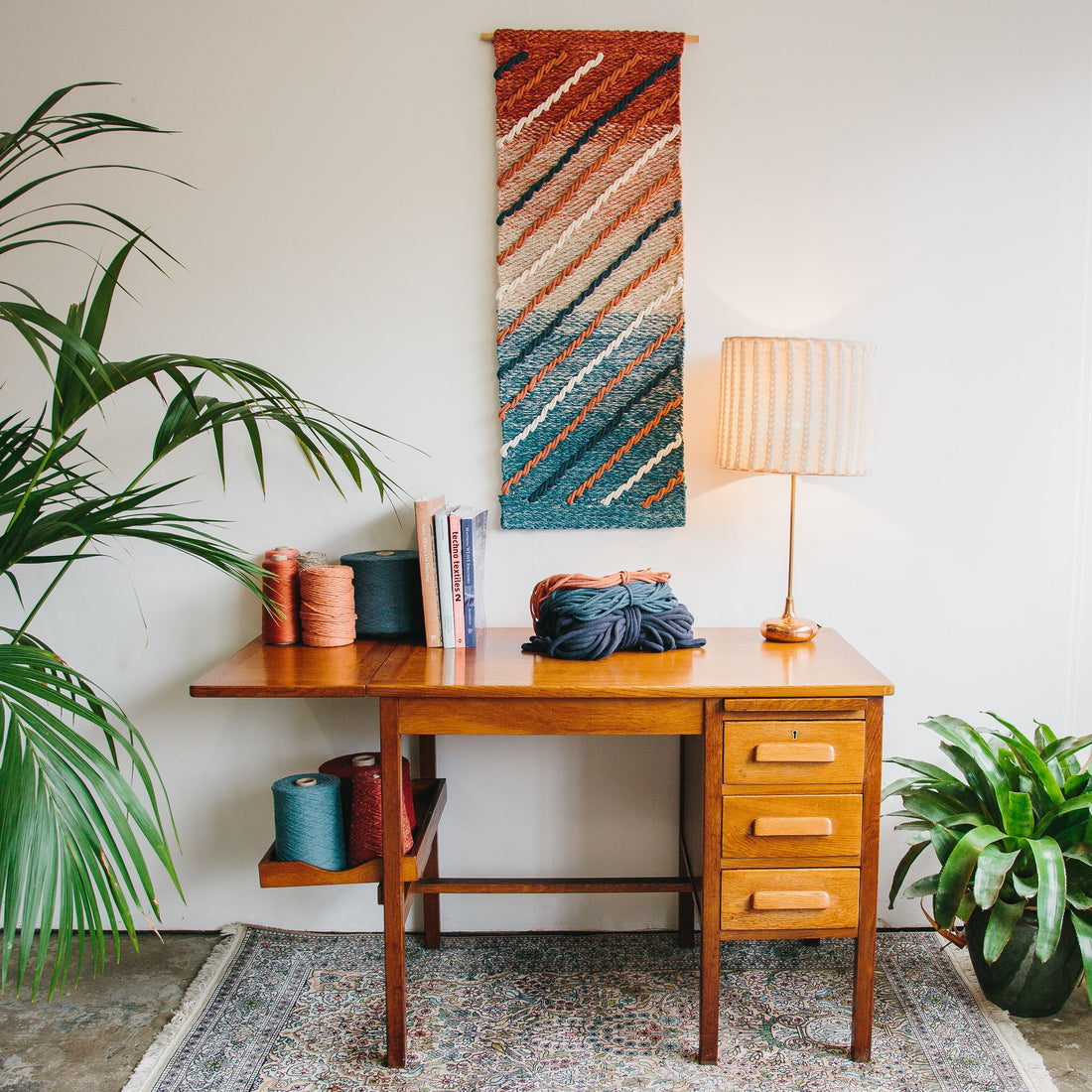
What Is Tapestry Weaving? Understanding the Process & Its Modern Applications
Share
Last week, I wanted to write about the difference between hand-weaving and tapestry weaving, but I found that I had so much to say about each subject that I decided to split this topic into two blog posts (OK, three blog posts actually—so tune in next week!).
This week, I’m diving into the tapestry weaving process.
Let’s get started!
The Process of Tapestry Weaving
Tapestry weaving is a hand-manipulated technique of creating cloth that involves working with one (or more) discontinuous weft threads (horizontal threads) passing through the warp (vertical threads) in an irregular sequence to build up rows of woven cloth.
By working with short, discontinuous lengths of yarn, you can control whether your pattern repeats or not—and if it does, the repeat can occur across an irregular number of warp threads. Essentially, you have greater control over the placement of the yarn, allowing for more flexibility to ‘draw with yarn.’
To achieve this, the warp is generally spaced wider apart and made from a thick, neutral-coloured yarn. This setup ensures that the colourful weft yarns completely cover the warp threads, resulting in what is known as a weft-faced cloth, a densely packed textile where the discontinuous weft threads are securely woven in, creating a stable fabric.
(Photos from left to right: 1, 2, 3, Cassandra Smith)



Creating Painterly Effects in Tapestry Weaving
The nature of this process enables the weaver to create a woven cloth that has a painterly quality. By changing the colors of the weft threads in small, specific locations, the weaver can create highly detailed designs using yarn.
A modern analogy would be the pixel ratio in a photograph, the more pixels, the more definition and detail the cloth can have.
Historically, the simplicity of this type of weaving is what made it unique. By working with only one pattern (plain weave) and restricting the yarns to a single type or quality of weft yarn, the result is a uniform, flat cloth that completely covers the warp yarns, producing extraordinary, detailed works of art.
Of course, contemporary tapestry weavers don’t always adhere to these traditional constraints. Today, many artists experiment with texture, materials, and innovative techniques, pushing the boundaries of what tapestry weaving can be.
(Photos from left to right: 1 & 2 Cassandra Smith, 3, Christabel Balfour)



Challenges of Tapestry Weaving
One of the primary challenges of tapestry weaving is that it is inherently a handwoven process. Because each section of the weft starts and ends in different locations across the warp, standard industrial looms are not designed to efficiently or cost-effectively produce tapestries.
(That said, I must admit that this is no longer strictly true - modern Jacquard looms can now produce intricate tapestries on an industrial scale. However, for hobby weavers and artisans, hand-weaving remains the primary method.)
The stop-start nature of tapestry weaving also means that it is a slow and labour-intensive process. Once a tapestry is complete, there is still additional work to be done - such as securing the many loose ends on the back of the piece to ensure stability.
Types of Looms Used in Tapestry Weaving
Most tapestry weavers work on either:
-
An upright tapestry loom, which has a mechanism for switching picks (or rows) of plain weave, semi-automating the process.
-
A frame loom, available in various sizes, which requires entirely manual weaving.
Both loom types are generally positioned upright or at a slight recline to allow for comfortable weaving over long periods.
A key advantage of these looms is that they enable the weaver to view their work in its entirety. By stepping back or holding the piece at arm’s length, the weaver can assess their progress and see how small sections relate to the overall composition—similar to how a painter or illustrator works.
While it is technically possible to weave tapestries on a floor loom or hand loom, these setups require winding the warp around a beam as the work progresses. This obscures the weaver’s view of the full design, making complex and intricate patterns more challenging to execute.
(Photos from left to right: 1, Jacqueline James Rugs, 2: Angie Parker Textiles, 3: Cassandra Smith)



Tapestry Weaving Today
In contemporary weaving, tapestry designs generally fall into two categories: rugs and wall hangings.
-
Flatwoven rugs and floor coverings are what many people associate with tapestry weaving. These textiles are characterized by their dense, flat construction, often made with thick, durable wool. You’ll find examples of these in many modern homes today.
(Photos from left to right: 1, Jacqueline James Rugs; 2, Angie Parker Textiles; 3, Cassandra Smith) -
Wall hangings are more decorative in nature, designed to be displayed rather than used as functional textiles. Many incredible traditional examples can be found in historic churches and museums worldwide. More recently, contemporary wall hangings have become a popular way to introduce warmth and texture into homes and workspaces.
Today’s tapestry weavers are experiencing a resurgence as new techniques and materials become more accessible.
This has led to a wave of contemporary artists pushing the boundaries of what is typically considered tapestry weaving, creating one-of-a-kind works of art that redefine the craft.
If you are interested in getting your hands on tapestry weaving tools, you can pick them up here on the website.
Next week, I’ll be wrapping up this series with another post, stay tuned!
Happy weaving!
Cass

1 comment
Hi I live in South Africa .Do you do online courses
Thank you